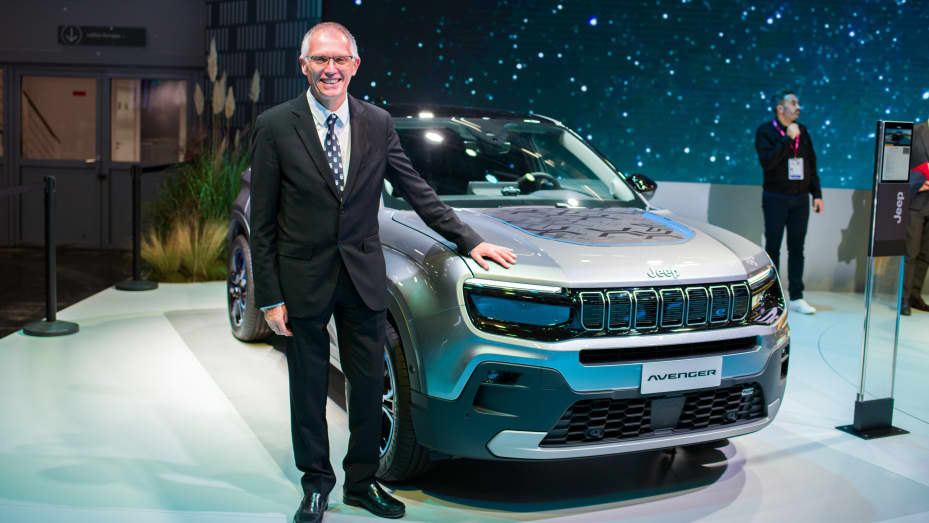
The CEO of Stellantis told CNBC Monday that the company would use its own sites to generate half the energy it needs for manufacturing by the middle of this decade.
“We have decided the appropriate investments for Stellantis to be able, from a manufacturing standpoint, in 2025 to produce 50% of our energy needs within our own sites,” Carlos Tavares, who was speaking to CNBC’s Charlotte Reed at the Paris Motor Show, said.
Tavares’ comments came as Stellantis geared up to debut what he called the “first pure-EV Jeep” after details of the vehicle were published last month.
According to Stellantis, the Jeep Avenger’s “targeted electric range” is 400 kilometers, or a little under 249 miles.
The firm — whose brands include Fiat, Chrysler and Citroen — is set to open up reservations for the Avenger on Monday, and it’s slated to arrive in showrooms next year.
Stellantis wants all passenger sales in Europe to be battery electric by the year 2030. In the U.S., it wants a “50% passenger car and light-duty truck BEV sales mix” within the same timeframe.
The above targets come as major economies lay out plans to move away from the internal combustion engine in favor of battery electric vehicles.
The European Union, for example, plans to stop the sale of new diesel and gasoline cars and vans from 2035. The U.K., which left the EU on Jan. 31, 2020, is pursuing similar targets.
Stellantis’ plans to focus on its own energy supplies are not unique within the automotive industry. In a separate interview with CNBC, the CEO of Mercedes-Benz Ola Kallenius offered up an insight into his firm’s goals on that front, including plans to develop a wind farm in northern Germany.
Kallenius also said the company had “very recently made a decision with a European energy provider to build a large-scale project in the Baltic Sea.”
Shift to electric vehicles
During his interview with CNBC, Tavares was asked whether talk of recession, the cost of living crisis, inflation and energy prices would have a delaying effect on the shift to electric vehicles.
“Well of course, energy is the number one precondition for success of electrification, that is no surprise,” he replied.
“The question that you are asking me is the question that you should ask to the political leaders because, as you know, electrification has been triggered by regulations,” he said.
“So yes, of course it’s a bump in the road,” he later added. “I hope it’s a short term hurdle that we will be all able to overcome, and Stellantis is now full speed ahead with all the electric vehicles, starting with the new Jeep Avenger, the first pure EV Jeep.”
Asked about the EU’s plans to phase out the sale of new ICE cars and vans by 2035, Tavares said it was “clear that the decision to ban pure ICEs is a purely dogmatic decision.”
Expanding on his point, the Stellantis chief said he would recommend that Europe’s political leaders “be more pragmatic and less dogmatic.”
“I think there is the possibility — and the need — for a more pragmatic approach to manage the transition.”
Stellantis’ electric vehicle plans put it in competition with firms such as Elon Musk’s Tesla as well as companies like Volkswagen, Ford, and GM. According to the International Energy Agency, electric vehicle sales are on course to hit an all-time high this year.
In recent years, a range of factors have created pressure points when it comes to the supply of the materials crucial for EVs, an issue the IEA highlighted earlier this year in its Global EV Outlook.
“The rapid increase in EV sales during the pandemic has tested the resilience of battery supply chains, and Russia’s war in Ukraine has further exacerbated the challenge,” the IEA’s report noted, adding that prices of materials like lithium, cobalt and nickel “have surged.”
“In May 2022, lithium prices were over seven times higher than at the start of 2021,” it added. “Unprecedented battery demand and a lack of structural investment in new supply capacity are key factors.”
On the raw materials required for EVs and their batteries, Mercedes-Benz CEO Kallenius sketched out the current state of play as he saw it.
“Raw material prices have been quite volatile in the last 12 to 18 months — some have spiked and actually some have come back down again,” he said.
“But it is true as we become electric, all-electric and more and more automakers go into the electric space, there is a need to increase mining capacities and refining capacities for lithium, nickel, and some of those raw materials that are needed to produce electric cars.”
“We have everything that we need now, but we need to look into the mid to long term and work with the mining industry here to increase capacities.”